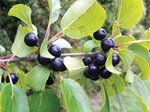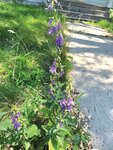


If you’ve taken a walk outside recently, you’ve probably noticed purple flower stalks popping up all around the neighborhood. Although they are beautiful, what you may not realize is that this is Creeping Bellflower, an aggressive non-native plant that can take over your flower beds and is very difficult to eradicate. Read on for more information about Creeping Bellflower and other aggressive, invasive, or noxious plants that are common in our neighborhoods.
First, some background. In Minnesota, the main list of invasive species is maintained by the Department of Natural Resources. These are non-native species that cause economic, environmental, or health-related harm; or threaten natural resources. Separately, the Department of Agriculture maintains a list of “noxious weeds,” which are highly regulated by law and must be eradicated in certain circumstances. Additionally, there are a number of other plants commonly referred to as “aggressive” or “nuisance” plants, which do not fall under the technical definition of an invasive species but can be just as much of a problem for home gardeners.
So, back to the plants. Creeping Bellflower is an aggressive/nuisance plant that is extremely common in south Minneapolis. It has bell-shaped purple flowers on 2-3-foot-tall stalks and is in bloom from July to October. Its leaves are heart shaped, and its stems usually have a reddish color. It spreads quickly, and is difficult to remove because of its extensive underground root system, including large, tuber-like storage roots that can be a foot or more underground. Even if you pull the stalks, the plant will regrow from those storage roots if you don’t dig them up – which is not an easy task.
As you can imagine, fully eradicating Creeping Bellflower is difficult. If you are able, the best practice is to use a garden fork to loosen the soil at least a foot deep and then gently remove the plant and its entire root system. However, this is not always practical if the plant is intertwined with other plants you want to keep or if it’s covering a large area. In this case, there are some herbicides that can be used, but you may need to reapply multiple times if the storage root is not killed after the first application. Check out the University of Minnesota Extension website for advice on specific herbicides. If neither of those options appeal to you, I would recommend at least removing the flowering stalks from Creeping Bellflower before they go to seed. Each plant can produce up to 15,000 seeds which disperse by wind, creating a host of new plants each year. Even if you aren’t able to eradicate Creeping Bellflower in your own yard, removing the flowering stalks helps prevent this nuisance plant from spreading even more widely.
Another common problematic plant in our area is Buckthorn, which is on the Restricted Noxious Weeds list. Buckthorn is a fast-growing perennial shrub. It was introduced to the United States in the 1880s for use as an ornamental hedge, but it has since become a serious threat to native forest ecosystems where it outcompetes native plants. The leaves of a Buckthorn plant are 1-2 inches long and generally egg-shaped, with serrated edges and a pointed end. It is easiest to identify by its clusters of small round black berries that ripen in August and September. These berries are very attractive to birds and other animals, who eat them and spread the seeds widely. Small Buckthorn plants can be uprooted using a root extractor or simply dug out with a shovel. Another option is to cut the plant down and use a small amount of herbicide on the cut stem. The University of Minnesota Extension website has advice on specific products and application methods to minimize risk to humans and wildlife when using herbicides.
Other common invasive and noxious plants in our area include Queen Anne’s Lace (which has lacy white flowers and carrot-like roots), Bull Thistle and Canada Thistle (spiky plants with purple/pink flowers), and Creeping Charlie (the common lawn weed with small purple flowers). Although it may be surprising that invasive plants are an urban issue, it’s important to be aware – and each of us can do our part to reduce the spread of these plants!
For more information, check out the University of Minnesota Extension Yard and Garden website. Extension resources are written by experts, and contain the latest and most reliable research-based information. Happy gardening!
Comments
No comments on this item Please log in to comment by clicking here